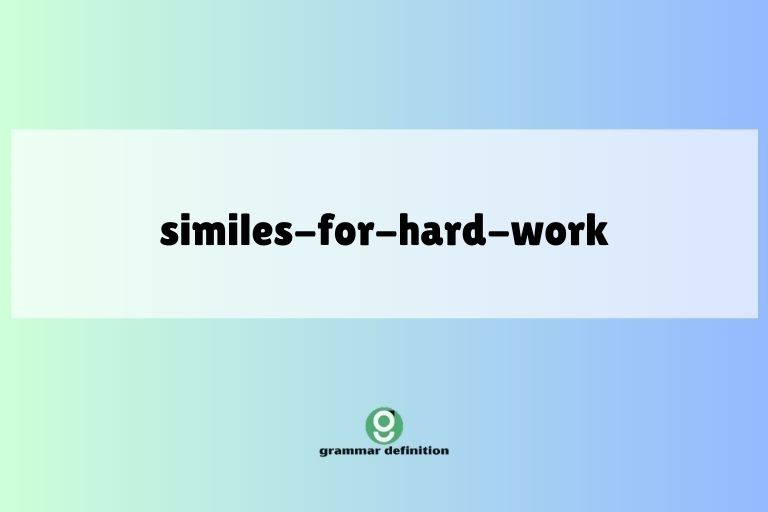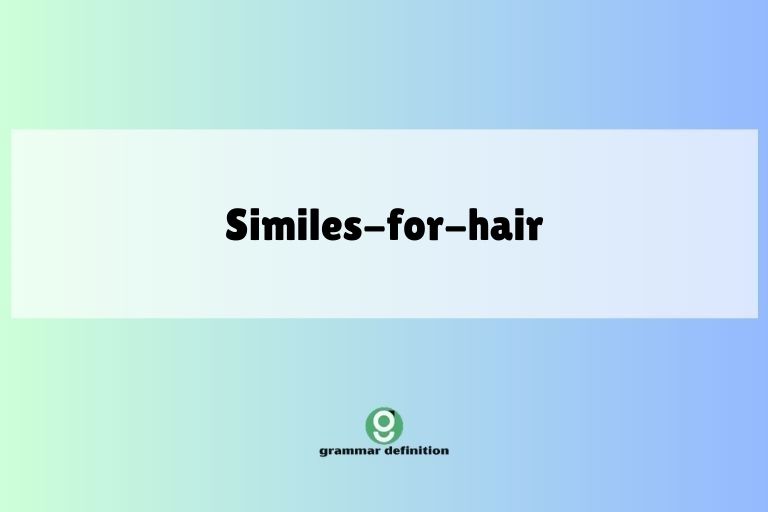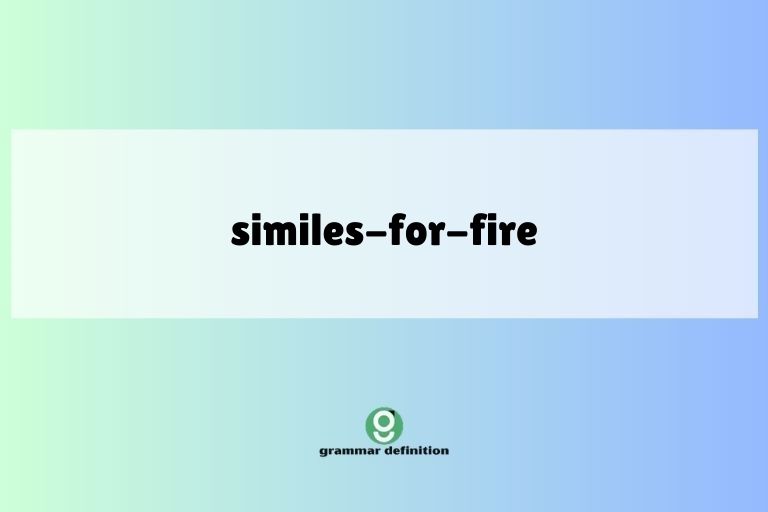Similes for Hard Work: A Comprehensive Guide

Understanding similes is crucial for enhancing your descriptive writing and adding vividness to your language. Similes, comparisons using “like” or “as,” help convey the intensity and nature of hard work in a relatable and impactful way.
This article provides a detailed exploration of similes for hard work, offering numerous examples, structural breakdowns, and practical exercises. Whether you’re a student, writer, or English language learner, this guide will equip you with the knowledge and skills to effectively use similes to describe effort and diligence.
This article is designed for anyone looking to improve their understanding and usage of similes, particularly in the context of describing hard work. It’s beneficial for students learning figurative language, writers aiming to add depth to their prose, and English language learners seeking to expand their vocabulary and comprehension.
By mastering the concepts presented here, you’ll be able to communicate the nuances of hard work with greater precision and creativity.
Table of Contents
- Definition of Similes for Hard Work
- Structural Breakdown of Similes
- Types of Similes
- Examples of Similes for Hard Work
- Usage Rules for Similes
- Common Mistakes with Similes
- Practice Exercises
- Advanced Topics in Similes
- Frequently Asked Questions
- Conclusion
Definition of Similes for Hard Work
A simile is a figure of speech that compares two unlike things using the words “like” or “as.” In the context of hard work, similes are used to illustrate the intensity, persistence, or nature of effort by drawing parallels with something else. They help create a vivid image in the reader’s mind, making the description of hard work more engaging and relatable.
Understanding similes involves recognizing the two elements being compared and the common characteristic they share.
Similes function to enhance descriptive writing by adding layers of meaning and emotional resonance. They allow writers to convey the feeling of hard work more effectively than simply stating “he worked hard.” For example, saying “He worked like a dog” conjures up a specific image of relentless, tireless effort.
The effectiveness of a simile lies in its ability to create a strong, immediate connection with the reader.
Similes for hard work can be found in various contexts, including literature, everyday conversation, and professional settings. They are used to describe physical labor, mental exertion, and any kind of dedicated effort.
The choice of simile depends on the specific aspect of hard work the writer wants to emphasize, whether it’s the difficulty, the duration, or the outcome.
Structural Breakdown of Similes
The basic structure of a simile includes three key components: the subject (the thing being described), the linking word (“like” or “as”), and the vehicle (the thing it is being compared to). The subject is the hard work itself or the person doing the hard work. The linking word establishes the comparison. The vehicle is the object or concept that shares a similar characteristic with the hard work being described.
For instance, in the simile “He worked like a machine,” “he” is the subject, “like” is the linking word, and “a machine” is the vehicle. The shared characteristic is the tireless, repetitive nature of the work.
Understanding this structure helps in both identifying and creating effective similes.
The power of a simile lies in the relationship between the subject and the vehicle. The more unexpected yet apt the comparison, the more impactful the simile will be.
A well-constructed simile not only describes but also evokes a feeling or understanding in the reader.
Types of Similes
Similes can be categorized based on the aspect of hard work they emphasize. They can also be categorized by the type of comparison they make.
Similes Emphasizing Intensity
These similes highlight the extreme effort involved in the work. They often use comparisons that suggest great force, pressure, or endurance.
Similes Emphasizing Persistence
These similes focus on the continuous, unwavering nature of the work. They often involve comparisons to things that are known for their consistency or reliability.
Similes Emphasizing Difficulty
These similes draw attention to the challenging or arduous nature of the work. They often compare the work to something that is inherently difficult or unpleasant.
Examples of Similes for Hard Work
The following tables provide extensive examples of similes for hard work, categorized by the aspect they emphasize. These examples illustrate the variety and creativity that can be used in constructing similes.
Similes Emphasizing Intensity
This table showcases similes that emphasize the sheer intensity and forcefulness of hard work.
| Simile | Explanation |
|---|---|
| He worked like a Trojan. | Implies tireless, relentless effort, drawing from the Trojan warriors’ legendary endurance. |
| She worked as hard as a beaver building a dam. | Highlights the industrious and persistent nature of building something complex. |
| They worked like ants in a colony. | Emphasizes collective, continuous, and organized effort. |
| He toiled like a blacksmith at his forge. | Conveys the image of strenuous physical labor and heat. |
| She studied as if her life depended on it. | Indicates extreme dedication and the high stakes involved. |
| He pushed himself like an athlete in training. | Suggests rigorous self-discipline and striving for peak performance. |
| She worked like a dog. | Implies tireless and often thankless labor. |
| He strived as hard as a climber scaling Everest. | Highlights the immense challenge and determination required. |
| She focused like a laser beam. | Emphasizes intense concentration and unwavering focus. |
| He labored like a miner digging for gold. | Conveys the idea of persistent effort in pursuit of something valuable. |
| She worked like a machine. | Implies tireless, efficient, and repetitive effort. |
| He worked as hard as a busy surgeon. | Highlights the need for precision, speed, and focus under pressure. |
| She worked like a horse. | Implies strong, tireless effort, particularly in physical labor. |
| He worked like a man possessed. | Suggests an almost obsessive level of dedication and energy. |
| She worked as if she were racing against time. | Emphasizes urgency and the need to complete tasks quickly. |
| He worked like a tireless engine. | Conveys continuous and powerful effort without stopping. |
| She worked as hard as a single mother raising children. | Highlights the demanding and multifaceted nature of the work. |
| He worked like a seasoned professional. | Implies skilled, efficient, and dedicated effort. |
| She worked like a bee in a hive. | Emphasizes busy, collaborative, and productive work. |
| He worked like a man trying to outrun his past. | Suggests a desperate, driven effort to escape or overcome something. |
| She worked as if the world depended on it. | Indicates a sense of immense responsibility and dedication. |
| He worked like a beaver on overdrive. | Highlights extremely industrious and persistent nature of building something. |
| She worked as hard as a programmer debugging code. | Emphasizes the meticulous and challenging nature of problem-solving. |
| He pushed himself like an Olympic athlete. | Suggests rigorous self-discipline and striving for peak performance. |
| She focused like a hawk hunting its prey. | Emphasizes intense concentration and unwavering focus to achieve a goal. |
Similes Emphasizing Persistence
This table presents similes that focus on the continuous and unwavering nature of hard work.
| Simile | Explanation |
|---|---|
| He worked like a river, constantly flowing. | Implies continuous, unwavering progress towards a goal. |
| She persisted like water wearing down a stone. | Highlights the power of consistent, relentless effort over time. |
| They kept at it like a dripping faucet. | Emphasizes the cumulative effect of small, persistent actions. |
| He followed through like a train on its tracks. | Conveys the idea of sticking to a plan or commitment without deviation. |
| She never gave up, like the sun rising each day. | Highlights unwavering reliability and consistency. |
| He kept going like a marathon runner. | Suggests endurance and the ability to sustain effort over a long period. |
| She chipped away at it like a sculptor with marble. | Implies gradual progress through meticulous and persistent effort. |
| He remained steadfast like a lighthouse in a storm. | Emphasizes resilience and unwavering commitment in the face of adversity. |
| She pursued her goals like a heat-seeking missile. | Highlights relentless focus and determination to achieve a specific objective. |
| He stayed the course like a sailor navigating by the stars. | Conveys the idea of maintaining direction and purpose despite challenges. |
| She worked relentlessly, like a clock ticking. | Implies constant, steady effort without pause. |
| He kept at it like a dog with a bone. | Emphasizes persistent determination and refusal to let go. |
| She returned to the task like a homing pigeon. | Highlights a natural or instinctive drive to complete the work. |
| He persevered like a tree weathering a storm. | Conveys resilience and the ability to withstand challenges. |
| She continued like a river carving through rock. | Implies gradual but powerful and persistent progress. |
| He stuck to it like glue. | Emphasizes unwavering commitment and dedication to the task. |
| She held on like a lifeline. | Highlights the importance of perseverance and not giving up. |
| He pressed on like a soldier in battle. | Suggests relentless determination in the face of adversity. |
| She toiled on like a farmer tending his crops. | Conveys the idea of consistent, ongoing effort over time. |
| He plugged away like a student cramming for exams. | Emphasizes concentrated effort over a limited period. |
| She persisted like a vine climbing a wall. | Highlights gradual but persistent progress towards a goal. |
| He worked like a squirrel gathering nuts for the winter. | Implies diligent and continuous effort in preparation for the future. |
| She worked tirelessly like a hummingbird flitting from flower to flower. | Emphasizes relentless activity and continuous effort. |
| He kept going like a wind-up toy. | Suggests mechanical, unceasing effort driven by a programmed purpose. |
| She followed through like a detective piecing together clues. | Conveys the idea of methodical, persistent investigation to solve a problem. |
Similes Emphasizing Difficulty
This table includes similes that highlight the challenging and arduous nature of hard work.
| Simile | Explanation |
|---|---|
| It was as tough as nails. | Emphasizes the resilience and unyielding nature of the work. |
| It felt like climbing a mountain. | Highlights the steep challenge and effort required to succeed. |
| It was like pulling teeth. | Implies an extremely difficult and frustrating task. |
| It was as hard as cracking a safe. | Conveys the need for precision, skill, and perseverance. |
| It was like trying to catch smoke. | Emphasizes the elusive and unattainable nature of the goal. |
| It felt like swimming upstream. | Suggests struggling against opposition or resistance. |
| It was like walking through treacle. | Implies slow, difficult progress due to obstacles. |
| It was as challenging as solving a Rubik’s Cube blindfolded. | Highlights the complexity and difficulty of the task. |
| It felt like fighting a losing battle. | Emphasizes the sense of futility and overwhelming odds. |
| It was like navigating a maze in the dark. | Conveys the uncertainty and difficulty of finding a solution. |
| It was as difficult as herding cats. | Implies a chaotic and uncontrollable task. |
| It felt like carrying the weight of the world. | Emphasizes the immense burden and responsibility. |
| It was like pushing a boulder uphill. | Suggests a strenuous and seemingly impossible task. |
| It was as taxing as running a marathon. | Highlights the physical and mental exhaustion involved. |
| It felt like wading through mud. | Implies slow, laborious progress with many obstacles. |
| It was like untangling a ball of yarn. | Emphasizes the need for patience and meticulous effort. |
| It was as painful as pulling off a bandage. | Conveys an unpleasant and difficult experience. |
| It felt like trying to empty the ocean with a teaspoon. | Emphasizes the futility of the task. |
| It was like building a house on sand. | Suggests an unstable and unreliable foundation. |
| It was as frustrating as banging your head against a wall. | Highlights the futility and exasperation of the task. |
| It felt like walking on eggshells. | Implies a delicate and precarious situation. |
| It was like being caught in a whirlwind. | Emphasizes the chaotic and overwhelming nature of the task. |
| It was as grueling as boot camp. | Highlights the intense physical and mental demands of the work. |
| It felt like unraveling a never-ending knot. | Emphasizes the complexity and frustration of the task. |
| It was like trying to nail jelly to a tree. | Suggests an impossible and absurd task. |
Usage Rules for Similes
Using similes effectively requires understanding and adhering to certain rules. First and foremost, ensure that the comparison is logical and relatable. The vehicle should have a clear connection to the subject, making the comparison meaningful to the reader. Avoid comparisons that are too obscure or far-fetched, as they can confuse rather than clarify.
Another important rule is to maintain consistency in tone. The simile should align with the overall tone of your writing. A humorous simile might be inappropriate in a serious context, and vice versa. Consider the emotional impact of the simile on the reader and choose one that enhances the desired effect.
Finally, be original and avoid clichés. Overused similes like “worked like a dog” have lost their impact and can make your writing seem uninspired. Strive to create fresh and imaginative comparisons that capture the essence of hard work in a unique way.
Common Mistakes with Similes
One common mistake is using mixed metaphors as similes. A mixed metaphor combines two unrelated images, creating confusion. For example, “He was burning the midnight oil while climbing the ladder of success” combines two different images that don’t logically fit together.
Another mistake is using similes that are too vague. A simile should provide a specific image or feeling. Saying “He worked like someone busy” is too general and doesn’t offer any meaningful comparison.
A third mistake is using similes that are logically flawed. The comparison should make sense in the context of the sentence. For example, saying “He worked like a fish” doesn’t make sense unless you’re referring to a very specific, unusual behavior of a fish.
Here are some examples of correct and incorrect simile usages:
| Incorrect | Correct | Explanation |
|---|---|---|
| He worked like a house. | He worked like a machine. | A house doesn’t work; a machine does. |
| She was as persistent as a rock. | She was as persistent as water wearing down a rock. | Rocks are static, not persistent. Water eroding rock illustrates persistence. |
| He studied like something. | He studied like his life depended on it. | “Something” is too vague; the second example gives a specific context. |
Practice Exercises
These exercises will help you practice identifying and creating effective similes for hard work.
Exercise 1: Identifying Similes
Identify the similes in the following sentences and explain what two things are being compared.
| Question | Answer |
|---|---|
| 1. He worked like a beaver to finish the project on time. | Simile: “like a beaver.” Comparison: He and a beaver are compared in terms of their industriousness. |
| 2. She was as focused as a hawk when she coded. | Simile: “as focused as a hawk.” Comparison: Her focus and a hawk’s focus are compared. |
| 3. They toiled like ants building their colony. | Simile: “like ants.” Comparison: Their toiling and ants building are compared. |
| 4. He pushed himself as hard as an athlete during training. | Simile: “as hard as an athlete.” Comparison: His effort and an athlete’s effort are compared. |
| 5. She studied as if her future depended on it. | Simile: “as if her future depended on it.” Comparison: Her studying and a life-or-death situation are compared. |
| 6. He was as tough as nails when facing challenges. | Simile: “as tough as nails.” Comparison: His resilience and the toughness of nails are compared. |
| 7. She persisted like water wearing down stone. | Simile: “like water wearing down stone.” Comparison: Her persistence and water’s erosion are compared. |
| 8. He kept at it like a dog with a bone. | Simile: “like a dog with a bone.” Comparison: His persistence and a dog’s determination are compared. |
| 9. It felt like climbing a never-ending mountain. | Simile: “like climbing a never-ending mountain.” Comparison: The difficulty of the task and climbing a mountain are compared. |
| 10. The task was as frustrating as herding cats. | Simile: “as frustrating as herding cats.” Comparison: The task’s frustration and herding cats are compared. |
Exercise 2: Completing Similes
Complete the following sentences with an appropriate simile to describe hard work.
| Question | Answer |
|---|---|
| 1. He worked _________ to meet the deadline. | He worked like a man possessed to meet the deadline. |
| 2. She was as dedicated as _________ when completing the project. | She was as dedicated as a surgeon performing a critical operation when completing the project. |
| 3. They continued their efforts, _________. | They continued their efforts, like a river carving through rock. |
| 4. The task was as challenging as _________. | The task was as challenging as solving a complex equation. |
| 5. He approached the problem _________. | He approached the problem like a detective solving a mystery. |
| 6. She studied _________ for her exams. | She studied as if her future depended on it for her exams. |
| 7. He toiled _________ in the hot sun. | He toiled like a farmer in the field in the hot sun. |
| 8. She approached the challenge _________. | She approached the challenge like a climber scaling a steep cliff. |
| 9. He worked _________ to achieve his goals. | He worked like a machine to achieve his goals. |
| 10. She was as determined as _________. | She was as determined as a marathon runner nearing the finish line. |
Exercise 3: Creating Similes
Create your own similes to describe the following scenarios of hard work.
| Scenario | Possible Simile |
|---|---|
| 1. A student studying late into the night. | He studied like an owl, perched and watchful through the long night. |
| 2. A construction worker building a skyscraper. | They toiled like busy ants, constructing a towering monument to human ambition. |
| 3. A programmer debugging a complex piece of code. | She worked like a surgeon, carefully dissecting the code to find the hidden flaw. |
| 4. An artist creating a masterpiece. | He painted as if possessed, pouring his soul onto the canvas with every stroke. |
| 5. An athlete training for the Olympics. | She trained like a warrior, pushing her body to its absolute limits. |
| 6. A writer working on a novel. | He wrote like a man obsessed, lost in the world of his story. |
| 7. A chef preparing a gourmet meal. | He cooked like a maestro, conducting a symphony of flavors in the kitchen. |
| 8. A scientist conducting groundbreaking research. | She researched like an explorer, charting new territories of knowledge. |
| 9. A teacher educating young minds. | He taught like a gardener, nurturing and cultivating the potential in each student. |
| 10. A volunteer helping those in need. | She volunteered like an angel, bringing comfort and hope to those who suffered. |
Advanced Topics in Similes
At an advanced level, similes can be used with greater nuance and complexity. This involves using extended similes, where the comparison is developed over several sentences or paragraphs, creating a more detailed and impactful image. It also includes using implied similes, where the linking word (“like” or “as”) is omitted, leaving the reader to infer the comparison.
Another advanced technique is to use similes subversively, creating an unexpected or ironic comparison to challenge conventional thinking. This requires a deep understanding of the subject matter and the ability to manipulate language for effect. For example, instead of saying “He worked like a machine,” you might say “He worked like a broken machine, constantly sputtering and stalling, but never giving up.”
Advanced learners can also explore the use of cultural references in similes, drawing on shared knowledge and experiences to create a deeper connection with the reader. However, this should be done with caution, as cultural references may not be universally understood.
Frequently Asked Questions
Here are some frequently asked questions about similes for hard work.
- What is the difference between a simile and a metaphor?
A simile compares two things using “like” or “as,” while a metaphor directly states that one thing is another, without using those words. For example, “He worked like a machine” is a simile, while “He was a machine” is a metaphor.
- How can I make my similes more creative?
To make your similes more creative, try to think outside the box and find unexpected comparisons. Use vivid imagery and sensory details to create a strong impression on the reader. Also, avoid clichés and try to come up with original comparisons.
- Can a simile be too long?
Yes, a simile can be too long if it becomes overly detailed or convoluted. The best similes are concise and to the point. If you find yourself writing a lengthy simile, consider breaking it up into smaller, more manageable parts.
- Is it okay to use similes in formal writing?
Yes, it is generally okay to use similes in formal writing, but use them sparingly and with careful consideration. Similes can add color and interest to your writing, but they should not distract from the overall message or tone. In highly technical or scientific writing, it’s best to avoid similes altogether.
- How do I avoid using clichés in my similes?
To avoid using clichés, try to come up with fresh and original comparisons. Think about the specific qualities of the subject you’re describing and look for unusual connections. You can also use a thesaurus to find synonyms for overused words.
- What makes a simile effective?
An effective simile creates a clear and vivid image in the reader’s mind. It should be logical, relatable, and consistent with the tone of your writing. It should also be original and avoid clichés.
- Can I use similes in spoken language?
Yes, similes can be used effectively in spoken language to make your descriptions more vivid and engaging. However, be mindful of your audience and the context of the conversation. Avoid using overly complex or obscure similes that may be difficult for others to understand.
- How do I choose the right simile for a particular situation?
To choose the right simile, consider the specific aspect of the subject you want to emphasize. Think about the qualities or characteristics you want to highlight and look for comparisons that effectively convey those qualities. Also, consider the tone and context of the situation.
Conclusion
Mastering similes is essential for enhancing your descriptive writing and effectively conveying the nuances of hard work. By understanding the structure, types, and usage rules of similes, you can create vivid and memorable comparisons that resonate with your audience.
Remember to avoid common mistakes like mixed metaphors and clichés, and strive to create original and impactful similes.
By practicing the exercises provided in this article and exploring advanced topics, you can further refine your skills and become a more effective communicator. Similes are a powerful tool for adding depth, color, and emotion to your writing, and with continued practice, you can master the art of using them to describe the multifaceted nature of hard work.
Keep exploring, experimenting, and refining your use of similes to bring your writing to life.






